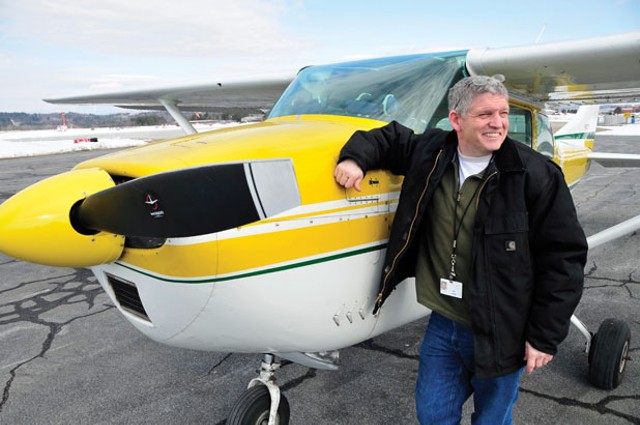Published April 28, 2010 at 5:49 a.m.
Tom Damon knows the name of every tall tree that towers over his country home in Morrisville: hemlock, red maple, black cherry and the fat, gnarly white pine. He also knows which ones are getting chopped down to make way for airplanes landing at the nearby Morrisville-Stowe State Airport: all of them.
Damon, a retired arborist, spent years pruning and tending the trees growing on his five-acre property in a private development off Route 100. He and his wife, Joanne, bought the modest clapboard home 20 years ago, in part because of the old-growth canopy under which it nestles.
Now Tom Damon says the state wants to “clear-cut” his yard as part of an airport expansion plan aimed at making the runway approach safer.
The Damons are angry about losing their largest trees and insulted by the price a state-contracted acquisition firm has offered to pay for them. A realtor hired by the couple says losing the trees would knock at least $75,000 off the home’s value. O.R. Colan Associates of Warwick, R.I., however, is offering the Damons less than a third of that amount, the couple says.
“It’s not fair,” Joanne Damon says. “They’re our trees. It’s our land. We landscaped it and cultivated it and enjoyed it for all these years. Now strangers want to come in with chain saws, and we don’t want that.”
The Damons and 10 neighbors living just south of the runway are losing trees that have encroached on the “glide path” of airplanes taking off and landing. That glide path is changing because the runway is being repaved and shifted 100 feet to the south. Plus, the runway safety area, a grass patch for planes that overshoot the tarmac, is being expanded to meet the Federal Aviation Administration’s minimum safety standards.
The $2.5 million project is part of a master plan for modernizing and expanding several of Vermont’s 10 state-owned airports.
Even as the state looks to sell an underused airport in the Northeast Kingdom town of Island Pond, the Vermont Agency of Transportation (VTrans) is pursuing a multimillion-dollar campaign to transform several other small airfields into more modern aviation hubs that it hopes will lure businesses, executives and high-rolling tourists eager to spend money and create jobs in Vermont.
The Douglas administration believes that with more hangar space, better marketing and longer runways capable of accommodating light jets and larger propeller planes, these far-flung airports can become economic engines that bring jobs and tourism to some of Vermont’s most economically hard-hit regions.
The administration has two goals here: First, to bring outdated air facilities into compliance with FAA safety requirements, thereby ensuring that federal dollars continue to flow. And second, to turn the airports themselves from money losers that cost the state $1 million each year into moneymakers.
It’s an ambitious plan that’s getting loud support from business and tourism leaders. But not everyone is on board.
The Damons and other homeowners impacted by the airport projects complain that their properties are being devalued for the benefit of wealthy private-plane owners and corporations that whisk VIPs in and out of the small airports.
Today, the Damons can see lights from the Morrisville-Stowe airport shining over the tops of their trees. Once those trees are gone, they fear the glare will beam right in their windows.
“It is a forest and has a wilderness feeling,” Joanne Damon says of their yard. “We’ve had bear and moose in our yard. Now we’ll be able to look right in the neighbors’ windows, which is like every other suburb.”
Why should anyone care about a few underperforming state airports? After all, even $1 million in losses looks puny next to the $595 million transportation bill passed at the Statehouse last week.
For one thing, average Vermonters are paying for the airports’ losses — whether they use them or not. For another, the state is facing a $155 million budget deficit, and leaders in Montpelier have cut state funding to safety-net programs that serve the sick, children, the poor and the elderly, turning to federal stimulus dollars to make up the difference. With every state program under the funding microscope, it’s worth asking: Is aviation getting a free pass?
To say that Vermont’s small airports fly under most people’s radar would be an understatement. Unless you own a plane or have taken flying lessons, ridden in a hot-air balloon or gone skydiving, you may never have set foot on their tarmacs. Vermont’s small airfields are probably better known for the hippie mega-concerts they’ve hosted than for anything to do with flight. Phish played its “farewell” show in Newport in 2004, and the Grateful Dead drew legions of fans to Franklin County State Airport in the summers of 1994 and ’95.
Only one of these airports, Rutland-Southern Vermont Regional Airport, offers commercial air service, via Cape Air. Years ago, a few had commercial carriers with flights to East Coast hubs. But these days, they mostly serve sport pilots, aviation-related businesses, tourists, second-home owners and, occasionally, officials performing drug busts or wildlife bait drops. Burlington International Airport, the state’s largest and busiest aviation hub, is municipally owned and in a league of its own, outside the scope of this story.)
But now big changes are afoot. Several of the airports are slated for modernization projects. Earth moving has already begun at Edward F. Knapp State Airport in Berlin, where $6 million in federal stimulus money is paying for a new taxiway, a “tie-down apron” where planes can park, and reconstruction of the crosswind runway.
Middlebury State Airport, historically a hub for crop-dusting planes, is getting new security fencing and, eventually, a longer runway — for $2 million to $3 million. In Rutland, VTrans is sinking up to $10 million in state and federal funds into a longer runway safety area. Newport State Airport got a new fence to keep bears and moose from wandering onto the tarmac, and plans for a runway extension are attracting $450,000 in private investment from a company that wants to see the airport grow.
Plus, a state-hired consulting firm recently completed a series of business plans that are chock-full of data and recommendations for bringing the airports into the 21st century.
In the big picture, the regional airports are big winners for Vermont, pumping $90 million a year into the state’s economy, according to a 2003 economic impact study commissioned by VTrans. That figure includes the payrolls of everyone directly employed through the airports; the impact of air-dependent businesses such as cargo carrier Wiggins Airways; and the money spent by air visitors at Vermont hotels, restaurants and retail stores.
But the airports themselves are chronic losers, running a combined deficit of $1 million a year.
How do a few little airports spill that much red ink? In short, they get so little use that money from hangar leases, fuel taxes and landing fees can’t cover the modest cost of keeping the runways plowed, the grass mowed and the terminal buildings staffed and heated. The full scope of the problem is detailed in a series of newly released business plans prepared for the state by consulting firm McFarland Johnson of South Burlington.
The worst offender is Edward F. Knapp State Airport in Berlin, a pair of asphalt runways with a squat, gray terminal building on one side. By McFarland Johnson’s calculations, Knapp’s deficit tops $140,000 a year and, if left unchecked, will balloon to $155,800 within two years.
Other airports don’t perform much better. Consider these yearly deficits calculated by the consultants: Hartness State Airport in Springfield, $117,200; Newport State Airport, $71,000; Morrisville-Stowe State Airport, $70,000; William H. Morse State Airport in Bennington, $55,000; Franklin County State Airport, $24,000; Middlebury State Airport, $15,000; Caledonia County State Airport, $14,000; and John H. Boylan State Airport in Island Pond, $4500.
Rutland-Southern Vermont Regional Airport runs $326,000 in the red, the consultants estimate. But because it has commercial air service, Rutland qualifies for federal reimbursements to cover operating losses, says VTrans spokesman John Zicconi.
The other airports’ losses are recouped out of taxpayers’ pockets. VTrans subsidizes the airports using money from the state’s transportation fund, which is collected from taxes on gas and vehicle purchases, as well as DMV fees.
Zicconi downplays the airports’ deficits. He likens state airports to Amtrak, a habitual money loser that stays afloat only because of generous federal subsidies.
“Governments subsidize public transit for the good of the citizenry,” Zicconi says. “It’s no different than the local bus. It’s services that people need.”
But some wonder who the small airports are benefiting, and whether they’re really in the same league with public buses and trains. Doug Hoffer, a Burlington-based policy analyst who keeps close watch on statewide economic development policy, argues that airports should pay for themselves through fees charged to pilots and others who use them.
“I’m not suggesting we shouldn’t have little regional airports for rich people,” Hoffer says. “But shouldn’t they pay for it?”
Hoffer doesn’t doubt that airports pump millions into the state’s economy. He says the state’s 2003 economic study uses sound economic models. He only questions why all Vermont taxpayers should foot the bill for infrastructure used by a tiny handful of the citizenry.
VTrans aviation program manager Rich Turner responds that the public already pays for roads, rails and bridges most Vermonters never use. Airports are no different, Turner says.
To the suggestion of raising fees on airport users, VTrans is lukewarm at best. Turner views the prices charged for fuel, hangar leases and landing fees as taxes and says the Douglas administration has shown an aversion to hiking them. Zicconi doesn’t sound thrilled about the idea, either. “Sometimes there’s only so far you can go with fair prices,” he says. “There’s a point where the market can only bear so much.”
The airport business plans, however, suggest the market could easily bear higher prices. Newport State Airport has sold airplane fuel for $4.50 a gallon — below both the state average of $5.12 a gallon and the national average of $4.62 a gallon.
Knapp airport in Berlin leases hangar space for just 7 cents a square foot — half what it costs in Rutland and Springfield. Charging even 15 cents a square foot at Knapp would more than double the airport’s revenue while still holding the price below market value, according to McFarland Johnson.
Finally, at Caledonia County State Airport, which performs so poorly that McFarland Johnson recommended closing the facility outright, the price to “tie down,” or park, an airplane is just $25 a month — half the fee charged at airports in Oswego County, N.Y., Northampton, Mass., and Rochester, N.H.
VTrans doesn’t directly manage most airports but rather contracts with a number of independent “fixed-base operators” to provide maintenance, landscaping and ancillary services to pilots. For instance, Dave Whitcomb has been the fixed-base operator of the Morrisville-Stowe airport for more than two decades. He leases hangar space from the state, then collects money from pilots who park their planes in hangars and on the tarmac.
Whitcomb says that private planes start at around $40,000 for a single-engine aircraft, and that well-heeled tourists and corporate executives make liberal use of the airport. But he disputes the notion that the airport only benefits the wealthy.
“Stowe [airport] brings in a lot of tourists and a lot of people. That’s part of why people have jobs in the area,” Whitcomb says. “Everyone in Morrisville works in Stowe.”
At the Statehouse, views on the future of small airports are mixed. Rep. Patrick Brennan (R-Colchester), chairman of the House Committee on Transportation, tells Seven Days the airports are a “back-burner” issue to him. Repaving roads and replacing the Lake Champlain Bridge take priority on the to-do list.
The chairman of the Senate Committee on Transportation, Sen. Dick Mazza (D-Grand Isle), however, says his patience for money-losing airports is running thin.
“This has to come to an end sooner or later,” says Mazza. “I think we’ve got to get to the point where they break even or make some money here somehow.”
Mazza remembers fighting Howard Dean when the former governor proposed closing Vermont’s state-owned airports a decade ago. Today, Mazza says he’s shocked at the deficits airports are running and is no longer convinced the state should maintain sole ownership of them.
Mazza is less troubled, however, about homeowners such as the Damons who are losing property to growing airports. He suggests they knew what they were getting into. “If it’s going to expand to help the community or industry, I mean, we’ve got to do it,” Mazza says. “The airport’s been there. It’s not like a brand-new airport. People who locate next to an airport ... it might possibly expand some day.”
Opponents of the “improvement” projects are by no means all anti-airport NIMBYs. The Damons say they’ve mostly enjoyed living near the airfield and watching the planes come and go. Though neither has flown out of Morrisville-Stowe, Tom and Joanne Damon say they understand why regional airports, and the businesses that crop up around them, matter.
Their neighbor, 83-year-old Andrew Gergely, built his Morrisville home where it is because it was near the airport. A pilot, Gergely used his own Piper Cherokee 140 for business and pleasure and for a time commuted to New Jersey for a job. He built his house 20 degrees off the runway approach, he says, because he knew it would be out of the traffic pattern.
Now that traffic pattern is changing — and Gergely’s 10-acre property with it. Like the Damons, Gergely is losing trees, and he’s fighting the acquisition company for a better price. He won’t specify how much, other than to say it’s dramatically less that what he believes the trees are worth.
Gergely’s problem with the Morrisville-Stowe project is that it’s “totally unnecessary,” he says. “There’s no commercial value to it other than to a few rich guys out of Stowe and a few people who want to capitalize on commercialization of the area.”
Not all locals may see value in the Morrisville-Stowe airport, but the will — and money — to expand it is there. The story of Island Pond’s John H. Boylan State Airport is quite a different one. It’s so little used that VTrans wants to sell it to a wood-pellet manufacturer that would use it as a log yard and create 160 new jobs.
Island Pond, a remote hamlet of 1300 people, lost its largest employer when Ethan Allen closed its furniture factory there in 2001. Today the town has 11 percent unemployment; some residents commute up to an hour each way for jobs.
Fewer than four planes use the football-field-sized airport each week, and in winter it all but shuts down; only planes equipped with skis can land there. The airport’s contribution to the state’s economy, about $53,000, is by far the lowest of any state-owned airport.
Recognizing the need for jobs, Island Pond residents cast a nonbinding vote on Town Meeting Day in favor of selling the airport. Many expressed reservations about losing a facility that’s been around for decades, but the promise of employment won out.
“Half the houses in town are for sale,” Island Pond resident Kim Daggett told Seven Days on Town Meeting Day. “Anyone who wants to bring jobs to this town, we should be opening the doors and saying, ‘Come on in.’ Sometimes you have to make sacrifices. It’s as simple as that.”
How will the airports turn their losing pattern around? One solution comes up again and again in the state’s new business plans: Extend runways to accommodate bigger planes. Bigger planes mean more money — not just from fuel taxes and tie-down fees, but from the tourists and executives who arrive in them.
Business jets like Cessna Citation IIIs have trouble landing on some Vermont runways because they’re too short. Runway length limits the number of passengers and the amount of fuel jets can carry, and makes landing in inclement weather riskier.
The state eyed Newport’s airport as a candidate for a longer runway, but the FAA decided it doesn’t get enough traffic to justify the $4 million expense, which would be paid almost entirely by the feds. Undeterred, the state has pressed on and secured a $450,000 pledge from a private company toward runway expansion.
Casella Waste Systems, which operates the state’s largest landfill on property abutting the airport, has committed the money to the cause of studying, designing and building a runway extension that would accommodate light jets and bigger prop planes, says Casella vice president Joseph Fusco. Casella doesn’t own or use planes, Fusco says, but is funding the project out of a desire to be “good neighbors.”
“There’s an obvious recognition that that facility is a crucial element of economic development in the North Country,” Fusco adds. “There’s a measure of self-interest and a measure of community interest. It’s good for our business.”
McFarland Johnson also sees promise for a longer Newport runway: The consultants affirm estimates that plane traffic could shoot up 10 percent after the extension. The owners of nearby Jay Peak Resort want to see Newport airport grow, too, says resort president Bill Stenger, and are willing to market the airport to guests from the U.S. and Canada.
The state is contemplating a second moneymaking measure: to renegotiate contracts with the airport managers so that they — rather than VTrans crews — would do most of the maintenance. Guy Rouelle, who is VTrans’ aviation program operations specialist as well as the state’s official pilot, projects the state could save $150,000 a year on airport upkeep that way.
“Every time a runway light went out, VTrans maintenance folks would drive out and change it,” Rouelle says. “Agreements will be changed to tell fixed-base operators, ‘You change the lights. You mow the grass. Stormwater compliance? Go out and sniff the water after it rains.’”
Beyond lengthening runways, building more hangars and ramping up marketing campaigns, the airports’ business plans are filled with quirky, one-off schemes for making them profitable, some of which VTrans officials say are worth considering. They include opening a restaurant in the Franklin County State Airport, possibly run by the chef from Souza’s Brazilian Steakhouse in Burlington; renaming the Newport State Airport the “Newport-Northeast Kingdom Regional Skiport” to capitalize on its proximity to Jay Peak and Burke Mountain resorts; and partnering with Lyndon State College to launch an aviation program.
Clever ideas, but the bottom line is not encouraging. Even if every “revenue-enhancement” strategy in the reports were adopted, most of Vermont’s small airports would still be running big deficits through 2013 and beyond, McFarland Johnson projects.
The fact that these solutions won’t immediately put the airports in the black only adds to the frustration of homeowners such as the Damons. Tom and Joanne Damon are resigned to losing their trees. Tom has planted several smaller crab apples around his deck, which should remain safely beneath the flight path for many years to come.
They don’t expect a fortune for their lost property, but the couple hope by holding firm they’ll obtain a more generous compensation.
“You’re never going to get what you really want for a price,” Joanne Damon says. “But hopefully you get closer to something that’s fair.”
Vermonters can only hope the state’s investment in small airports gives them a fair deal, too.
More By This Author
Speaking of Local Issues, aviation
-

A Franklin County Nonprofit Is Drawing Young Women Into Aviation Careers
Feb 21, 2024 -

Weinberger Picks Longo for Burlington Aviation Director
Sep 14, 2022 -

Loaded With Cash and Poised to Expand, Beta Technologies Sees Clear Skies Ahead
Apr 26, 2022 -

Skier, Pilot and Shooting Survivor Manon Belzile Is the 'Motor Ninja' at Beta Technologies
Oct 20, 2021 -

WTF: Who’s Been Flying Aerial Stunts Over Southern Chittenden County?
Aug 4, 2021 - More »
Comments
Comments are closed.
From 2014-2020, Seven Days allowed readers to comment on all stories posted on our website. While we've appreciated the suggestions and insights, right now Seven Days is prioritizing our core mission — producing high-quality, responsible local journalism — over moderating online debates between readers.
To criticize, correct or praise our reporting, please send us a letter to the editor or send us a tip. We’ll check it out and report the results.
Online comments may return when we have better tech tools for managing them. Thanks for reading.















































